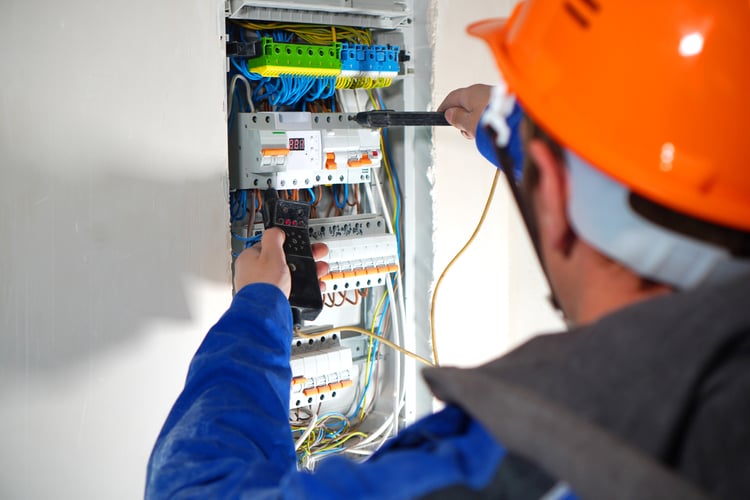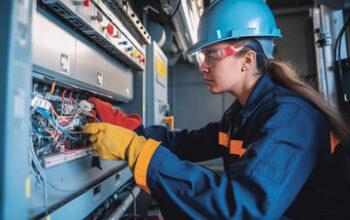Electricity is the physical phenomenon that involves matter with an electric charge. It is related to magnetism and forms part of the larger field of electromagnetism.
Voltage is the force pushing electricity along a circuit, measured in volts. Resistance is what slows the flow of current, and it’s measured in ohms. For more information, click the Visit Website to proceed.

Electricity has revolutionized our world, giving us lighting, appliances, and other devices that make work and play easier. It is a form of energy that involves moving electrons and magnetic fields, and it is the basis for many other types of phenomena, such as lightning and static electricity.
The basic electrical system in your home runs from the power company’s mains to your meter and through the main panel, usually located right next to or under the meter. From there, the power travels through circuits to your lights and receptacles. Each circuit has a hot wire that supplies power to the fixtures and a neutral wire that returns it to the main panel. The current must stay within the circuit; the device or fixture will burn out if it does not. The meter also connects the hot and neutral wires, which records the amount of electricity you use in your house.
If the current in a circuit gets too high, the breaker switches inside your main panel will shut off the flow of electricity. This safety feature is meant to prevent damage to the devices or your house itself. Each breaker is designed to handle a certain amount of electricity, and the individual breakers will be labeled to indicate what part of your house each one is responsible for.
Electrical wires, like the ones in your house, are made of metal that is a good conductor of electricity. This is because the outer electrons of the metal atoms are loose and can float around the center of the atom. These electrons have a positive charge and are attracted to each other, meaning they can carry electricity. The amount of charge is measured in coulombs, and the more electrons that are present, the more powerful the electricity will be. When it is not being used, the electrons are tightly packed and unable to move, so wires are insulated. The insulating materials also help keep the wires from melting or burning if they become overheated.
Electricity flows through circuits to provide power for lights and other devices. Scientists have developed models and metaphors to explain what happens in an electrical circuit, but the basics are simple. A basic circuit consists of a power source (such as a battery) connected to an electricity device, with wires connecting the two—the electric current moves from the power source through the device and back to the source.
In a simple electric circuit, the battery pushes electrons from its negative terminal to its positive terminal. The electrons flow through conducting wires to the light bulb and then the filament inside the bulb, generating heat that produces light. The electrons then move back to the positive end of the battery.
As more lights are added to a series circuit, the current available for each light decreases. This is because the electrons are going through more wires, which increases the resistance of the circuit. However, the amount of energy used by each light remains the same.
There are two general types of electric circuits: series and parallel. In a series circuit, all the parts are connected one after another. Electric current with the same voltage flows through each component in a series circuit. If one of the components burns out or is disconnected, the entire circuit breaks.
A parallel circuit contains multiple pathways or branches. Each branch has its separate power source, which can be either a battery or a light switch. When a light switch in a parallel circuit is closed, the metal piece of the switch closes to complete the circuit. When the light switch is opened, it creates a gap in the circuit, preventing current from flowing.
Electricity wants to find the path of least resistance, typically a straight line from the source to the load and back again. If there is a short circuit, the current will attempt to take the shortest route possible, which may damage the power supply or cause parts to overheat and start a fire. To prevent this, circuits are designed with switches, fuses, or circuit breakers to cut the current when needed.
Switches offer a way to connect network devices and boost network performance. They support full-duplex communication and effectively use bandwidth, helping to ensure that network devices can access the data they need without running into each other’s transmissions. They also help provide wired connections to printers, industrial machinery, and Internet of Things (IoT) devices like card entry systems. They also provide the means to connect network segments and link computers in a data center.
To work properly, a switch must be made of an electrical conductor that can easily pass electricity when closed. The best-known electrical conductor is metal, but other materials, such as plastics and some nonmetals, can be used to construct a switch. Switches come in various shapes, sizes, and configurations to meet various requirements, from simple unmanaged switches that offer plug-and-play connectivity to highly configured Gigabit Ethernet switches that deliver high-performance connections to the enterprise.
Network switches are available in many form factors, from stand-alone desktop units intended for use in a home or office environment outside a wiring closet to large chassis switches with swappable switch cards. Various mounting options are available, including rack-mounted switches for use in an equipment cabinet or other networking infrastructure, DIN rail mounted in an industrial environment, and small installation switches for cable ducts or a communications tower.
A network switch works at the OSI model’s data link layer, or layer 2, to create a separate collision domain for each port. It also helps to filter traffic and select how frames are forwarded based on the destination MAC address in each frame. A switch also maintains a database of addresses called the MAC address table. When a new device on the network communicates with a switch for the first time, the switch learns its MAC address and adds it to the MAC address table. The switch then knows which port on the switch to send incoming frames to for each MAC address. Using this information, the switch can forward packets to devices with their assigned ports quickly and reliably.
The term “electronics” refers to studying electricity and how it works. More specifically, it relates to studying circuits and components that allow electric current control. This knowledge can be applied to build electronic devices and other electrical systems, including power generation and distribution. Electronics is a subset of electrical engineering and has a much larger impact on modern life.
In general, electronic devices work by converting energy into information. They also manipulate electric currents to carry different signals, such as sound or images. In addition, they often use complex systems that involve multiple transistors, diodes, and integrated circuits. They differ from electrical systems, which typically use passive components such as resistors and capacitors.
Most electronics rely on semiconductors, metals with a structure that allows them to conduct electricity without dissipating too much energy. These are found in devices such as microprocessors and integrated circuits, which serve various functions in our daily lives, including communication, entertainment, and automation.
While most people know that they interact with electronics daily, the exact nature of how these systems work needs to be better understood. For example, your toaster uses a battery for electricity and converts it into heat energy. The toaster also has a switch that turns it on and off. The switch, in turn, is powered by an electric current transmitted to the toaster via a wire.
The electron identification in 1897 and the subsequent invention of vacuum tubes that could easily amplify and rectify small electrical signals inaugurated the field of electronics and the “electron age.” This allowed for the transmission of electrical signals with minimal loss, which made electronic devices possible, such as radio and audio signal transmitters.
Despite the many benefits of electronics, they have their disadvantages. Electronic waste is one of the fastest-growing waste streams and can contain dangerous heavy metals, such as lead, arsenic, cadmium, mercury, and brominated flame retardants. If these materials are not properly recycled, they can seep into soil and water, contaminating the environment and potentially harming people.


